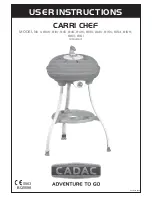
12
Meals began and ended around a fire. Over time, cooking
progressed from a simple skewer to a spit to early ovens. These
earthenware cooking vessels channeled and controlled the
fire’s heat for better flavor. Slowly, the rudimentary cooking
vessels evolved around the world, becoming the tandoor oven in
India and the charcoal-fueled mushikamado in Japan.
After the Second World War, American soldiers discovered
the superior, wood-fired flavor of the kamado and brought the
grill home to the States. Since then, the kamado grill has been
refined as a versatile ceramic cooker that continues to impress
with the incredible flavor and textures it produces. From rich,
smoked meat falling apart at the bone to crispy pizzas to juicy,
caramelized steaks seared over a hot flame—meals prepared in
the kamado taste elemental and true.
Our ancestors understood what we often forget: that time is
the best ingredient. Thousands of years ago, people gathered
around the kamado while their food cooked; today, despite our
sprawling kitchens and double ovens and induction stoves,
the kamado is still bringing people together around the fire.
More than a way of cooking, kamado is a way of connecting.
Connecting with the elements. With our hands, with our food.
With the people we love. It’s not fast food. Like any art, it takes
time. And the result is a meal that rewards us with unmatched
flavor—and the satisfaction of time well spent.
The Art of Kamado
FIRE TAMED THE WORLD—BECAUSE
WITHOUT FIRE, THERE IS NO COOKING
Содержание CLASSIC III KJ15040721
Страница 43: ......













































